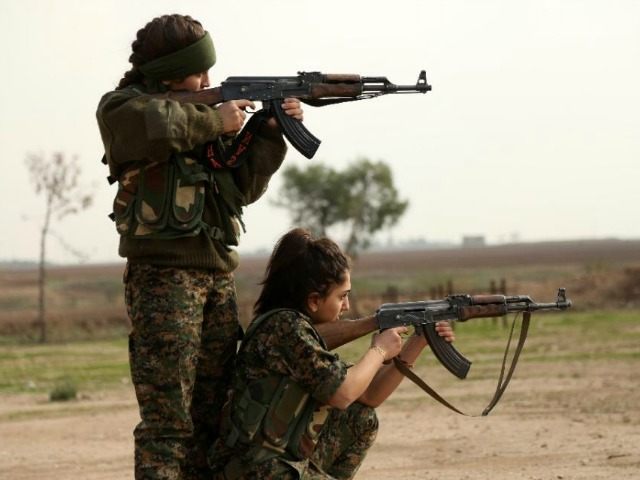A group of 50 Syriac Christian females have decided to pick up arms and fight against the Islamic State (ISIS/ISIL).
Babylonia, 36, left her two children and job as a hairdresser.
“I miss Limar and Gabriella and worry that they must be hungry, thirsty and cold. But I try to tell them I’m fighting to protect their future,” she explained.
https://twitter.com/RepoRobot/status/675978804255412224
The 50 females graduated from a training camp in Al-Qahtaniyeh, located in northeast Syria, to join the “Female Protection Forces of the Land Between the Two Rivers,” referring to the Tigris and Euphrates (ancient Mesopotamia). The town is historically associated with the Assyrians, with a population of just under 20,000. The Kurdish People’s Protection Unit (YPG) took control of the city in July 2012.
The militia and the Syrian Democratic Forces “recaptured Al-Hol.”
“I took part in a battle for the first time in the Al-Hol area, but my team wasn’t attacked by IS,” described Lucia, 18. “I fight with a Kalashnikov, but I’m not ready to become an elite sniper yet.”
Christian females in #Syria are all set to battle against #ISIShttps://t.co/XNged5q9jC pic.twitter.com/IyycpTcC6d
— India Today (@IndiaToday) December 13, 2015
Al-Hol was a major victory for the militia and SDF, since it is located on a route used by ISIS to travel between Syria and Iraq.
Thabirta Samir, 24, helps train the women along with “foreign forces.” However, she did not specify where those fighters originated.
“I used to work for a Syriac cultural association, but now I take pleasure in working in the military field,” she declared. “I’m not afraid of Daesh, and we will be present in the coming battles against the terrorists.”
Women from a Christian militia group are taking on ISIS as more females join the battle against the terrorist… https://t.co/mS3Ox4bs9N
— Julia Charnley (@JuliaCharnley) December 13, 2015
Others said that the Assyrian genocide – also known as the Sayfo (Sword) massacres – in 1915 inspired them to join the fight. During the massacres, the Ottoman empire murdered “tens of thousands of Christians in Turkey and Iran.” Ithraa, 18, explained their minority “is oppressed by others” and hopes to stop “a new massacre like that committed by the Ottomans … when they tried to erase our Christian and Syriac identity.”
The Syriac Orthodox Church is one of the oldest Christian churches, connected to the Church of Antioch, where followers of Jesus received the title of Christians. The members pray in Aramaic, which is the language of Jesus. The church is important to the history of Christianity:
The Church of Antioch played a significant role in the early history of Christianity. It played a prominent role in the first three Synods held at Nicea (325) , Constantinople (381), and Ephesus (431), shaping the formulation and early interpretation of Christian doctrines. In AD 451, the Council of Chalcedon and its Christological position resulted in a schism that divided the faithful under the Apostolic See of Antioch into two—one today known as the `idto suryoyto treeysath shubho (Syrian or Syriac Orthodox Church) and the other the Eastern Orthodox (or Rum Orthodox) Church of Antioch. The latter had the support of the Byzantinian Emperor Justinian who convened the Council of Chalcedon. The years that followed resulted in a struggle over the Apostolic See, with bishops of both persuasions assuming the position of Patriarch of Antioch. In 518, Patriarch St. Severus was exiled from Antioch. The seat of the Syriac Orthodox Patriarch of Antioch moved to different monasteries including Qartmin, Qenneshrin (Chalkis, near Aleppo), Malatya, and Amid (Diyarbakir), and finally settled in 1293 in Dayro d-Mor Hananyo (also known as Kurkmo Dayro in Syriac and Deir Zafaran in Arabic) in Mardin. It remained at this monastery until 1933 when the political circumstances forced its migration to Homs, Syria, and later to Damascus in 1959.
“I’m a practising Christian and thinking about my children makes me stronger and more determined in my fight against Daesh,” continued Babylonia.

COMMENTS
Please let us know if you're having issues with commenting.